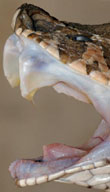VOA标准英语2011--Threat of Fatal Snakebites Often Overlooked(在线收听)
Threat of Fatal Snakebites Often Overlooked
Neglected tropical diseases such as dengue, leishmaniasis, and trachoma are getting more attention these days, but other health threats are almost completely off the radar.
One example is the deadly toll taken by venomous snakes, which was discussed by experts at the American Society of Tropical Medicine and Hygiene meeting in Philadelphia.
"Snakebite envenoming is a very acute and life threatening and complex condition," says Ulrich Kuch of the Biodiversity and Climate Research Centre in Frankfurt, Germany, who co-chaired a symposium on snakebite on Dec. 5.
The extent of the problem is a little unclear. A 2008 study found poisonous snakes cause as many as 94,000 deaths a year. But Kuch says that may understate the problem.
"New numbers from very rigorously designed and well-conducted studies in India and Bangladesh have come up with numbers that suggest that the real death toll of snakebites at the global level is much higher."
 |
| Western Russell's Viper, photographed in Hyderabad, India, is among the deadliest of snake species. |
Many people die needlessly from the bites of poisonous snakes, Kuch says, because many snakebite victims consult traditional healers or otherwise fail to seek medical attention.
"Either because there is no treatment available, or because health care staff do not know how to treat snakebites, or because transportation to get to a health facility is not available or too expensive."
There is no generic antivenom used to treat snakebite. A patient must be treated with an antivenom specific to the each particular species of snake. The life-saving antidote is often expensive, but cost - and availability - vary widely.
"For example, antivenoms in India, they are really not expensive. But you do have an issue of distribution and of training people in treating snakebites. In other countries, such as Laos for example and many other Asian and African countries, there's no antivenom at all."
Despite the challenges, Kuch says the atmosphere at the symposium on snakebites was positive.
Because using the right antivenom is critical, rapid diagnosis tests are being developed to help health workers determine which to administer. The tests are designed to be used in poor, rural areas.
Kuch also mentioned the experience of a community-based clinic in Damak, Nepal, which showed it is possible to save lives by treating snakebites locally with specially-trained paramedics, working in a facility that treats only snakebites.
"And they have been trained to recognize all the symptoms of snakebite envenoming and to give the proper treatment for that. And most of the patients they receive can be cured in that low-tech facility. Because snakebites are so common in this village, they treat more than 1,000 patients each year."
Volunteer motorcyclists can quickly bring snakebite victims from the surrounding area for treatment. The successful program has now expanded to other villages, and may be expanded to India as well.